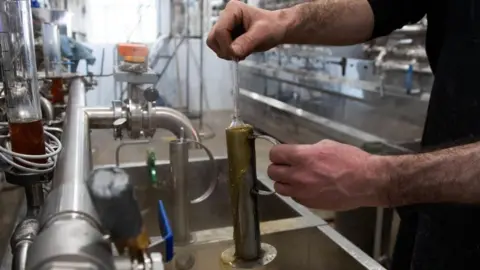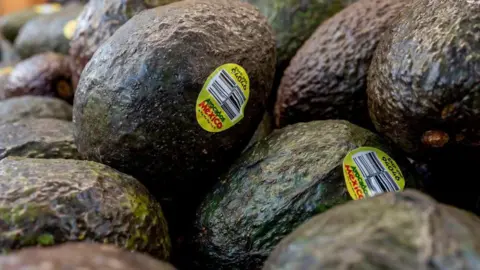Business reporter, BBC News
 Getty Images
Getty ImagesPresident Donald Trump has hit the pause button – for now, at least – on imposing tariffs against imports from US neighbours Canada and Mexico.
Last-minute agreements with the leaders of Mexico and Canada have suspended for a month a tit-for-tat trade war in North America.
The three trade partners have deeply integrated economies and supply chains, with an estimated $2bn (£1.6bn) worth of manufactured goods crossing the borders daily.
Trump says he wants to protect American industry, but many economists warn such duties could lead to prices rising for consumers in the US.
That’s because tariffs are paid by the domestic company importing the goods, who may choose to pass the cost on to customers directly, or to reduce imports, which would mean fewer products available.
So what could get more expensive if Trump’s tariffs do eventually go ahead?
Cars
Cars would probably go up in price – by about $3,000 according to TD Economics.
That’s because parts cross the US, Canadian and Mexican borders multiple times before a vehicle is assembled.
As a result of higher taxes paid on the importing of parts to build the cars, it is likely the costs will be passed on to customers.
“Suffice it to say that disrupting these trends through tariffs… would come with significant costs,” said Andrew Foran, an economist at TD Economics.
He added “uninterrupted free trade” in the car-making sector had “existed for decades”, which had led to lower prices for consumers.
Beer, Tennessee whiskey and tequila
 Getty Images
Getty ImagesPopular Mexican beers Modelo and Corona could get more expensive for US customers if the American companies importing them pass on the increased import taxes.
However, it’s also possible that rather than passing on the cost increase, firms could just import less.
Modelo became the number one beer brand in the US in 2023, and remains in the top spot, for now.
It’s more complex when it comes to spirits. The sector has been largely free of tariffs since the 1990s. Industry bodies from the US, Canada and Mexico issued a joint statement in advance of the tariffs being announced saying they were “deeply concerned”.
They say that certain brands, such as Bourbon, Tennessee whiskey, tequila and Canadian whisky are “recognized as distinctive products and can only be produced in their designated countries”.
So given the production of these drinks cannot simply be moved, supplies might be impacted, leading to price rises. The trade bodies also highlighted that many companies own different spirit brands in all three countries.
Houses
Imports of Canadian lumber would be hit by import tariffs to the US. Trump has said the US has “more lumber than we ever use”.
However, the National Association of Home Builders has urged the president to exempt building materials from the proposed tariffs “because of their harmful effect on housing affordability”.
The industry body has “serious concerns” that the tariffs on lumber could increase the cost of building homes – which are mostly made out of wood in the US – and also put off developers building new homes.
“Consumers end up paying for the tariffs in the form of higher home prices,” the NAHB said.
Maple syrup
 Getty Images
Getty ImagesWhen it comes to the trade war with Canada, the “most obvious” household impact would be on the price of Canadian maple syrup, according to Thomas Sampson, associate professor of economics at the London School of Economics.
Canada’s billion-dollar maple syrup industry accounts for 75% of the world’s entire maple syrup production.
The majority of the sweet staple – around 90% – is produced in the province of Quebec, where the world’s sole strategic reserve of maple syrup was set up 24 years ago.
“That maple syrup is going to become more expensive. And that’s a direct price increase that households will face,” Mr Sampson said.
“If I buy goods that are domestically produced in the US, but that are produced using inputs from Canada, the price of those goods is also going to go up,” he added.
Fuel prices
Canada is America’s largest foreign supplier of crude oil. According to the most recent official trade figures, 61% of oil imported into the US between January and November last year came from Canada.
While 25% has been slapped on Canadian goods imported to the US, its energy faces a lower 10% tariff.
Now the US doesn’t have a shortage of oil, but the type its refineries are designed to process means it depends on so-called “heavier” – i.e. thicker – crude oil from mostly Canada and some from Mexico.
“Many refineries need heavier crude oil to maximize flexibility of gasoline, diesel and jet fuel production,” according to the American Fuel and Petrochemical Manufacturers.
That means if Canada decided in retaliation to any US tariffs to reduce crude oil exports, that could lead to prices rising at the petrol pumps.
Avocados
 Getty Images
Getty ImagesOne food import that American consumers could see a significant price increase in is avocados. Grown primarily in Mexico due to its warm, humid climate, Mexican avocados make up nearly 90% of the US avocado market each year.
However, if tariffs come into force, the US Agriculture Department has warned that the cost of avocados – along with popular avocado-based dishes like guacamole – could surge, especially by Super Bowl Sunday on 9 February.
What about goods in Canada?
Before Trump’s agreement with Justin Trudeau to pause tariffs was announced on Monday, Canada had threatened retaliatory import taxes.
An initial C$30bn tranche had been due to begin on Tuesday – meaning prices would have probably increased for consumers north of the border as well.
Ottawa had released a list of all the US imports that would have immediately been targeted with matching 25% tariffs. They included grocery store staples, like oranges – a produce that Canada cannot grow in abundance due to its cooler climate.
Alcohol originating from the US would also be harder for Canadians to find. Provinces like Ontario, British Columbia, Manitoba, New Brunswick and Nova Scotia said they would pull all American booze off their shelves starting on Tuesday.
Any US alcohol – including beer and wine – that Canadians could find would likely see a price increase, as it’s on the menu for retaliatory tariffs.
Canadian shoppers might feel the pinch from a weaker Canadian dollar if shopping online.
Additional reporting by Lucy Acheson and Nadine Yousif

